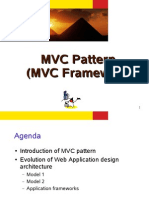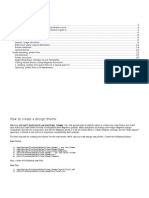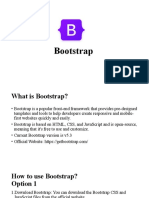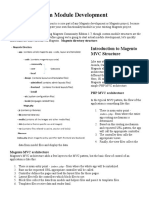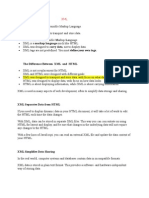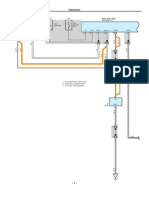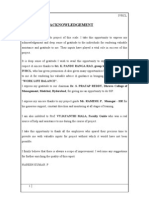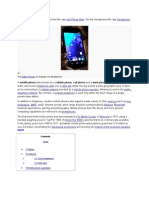Model View Controller (MVC) in PHP Tutorial
Uploaded by
Anonymous 3q6HiKModel View Controller (MVC) in PHP Tutorial
Uploaded by
Anonymous 3q6HiK6/20/2016
ModelViewController(MVC)InPHPTutorial
ModelViewController(MVC)InPHPTutorial
Themodelviewcontrollerpatternisthemostusedpatternfortodaysworldwebapplications.Ithasbeenused
forthefirsttimeinSmalltalkandthenadoptedandpopularizedbyJava.Atpresenttherearemorethana
dozenPHPwebframeworksbasedonMVCpattern.
DespitethefactthattheMVCpatternisverypopularinPHP,ishardtofindapropertutorialaccompaniedbya
simplesourcecodeexample.Thatisthepurposeofthistutorial.
TheMVCpatternseparatesanapplicationin3modules:Model,ViewandController:
Themodelisresponsibletomanagethedataitstoresandretrievesentitiesusedbyanapplication,usually
fromadatabase,andcontainsthelogicimplementedbytheapplication.
Theview(presentation)isresponsibletodisplaythedataprovidedbythemodelinaspecificformat.Ithas
asimilarusagewiththetemplatemodulespresentinsomepopularwebapplications,likewordpress,joomla,
Thecontrollerhandlesthemodelandviewlayerstoworktogether.Thecontrollerreceivesarequestfrom
theclient,invokesthemodeltoperformtherequestedoperationsandsendsthedatatotheView.Theview
formatsthedatatobepresentedtotheuser,inawebapplicationasanhtmloutput.
TheabovefigurecontainstheMVCCollaborationDiagram,wherethelinksanddependenciesbetweenfigures
canbeobserved:
Ourshortphpexamplehasasimplestructure,puttingeachMVCmoduleinonefolder:
Controller
Thecontrolleristhefirstthingwhichtakesarequest,parsesit,initializesandinvokethemodelandtakesthe
modelresponseandsendsittothepresentationlayer.ItspracticallytheliantbetweentheModelandtheView,
asmallframeworkwhereModelandViewarepluggedin.Inournaivephpimplementationthecontrolleris
implementedbyonlyoneclass,namedunexpectedlycontroller.Theapplicationentrypointwillbeindex.php.
Theindexphpfilewilldelegatealltherequeststothecontroller:
1.//index.phpfile
2.include_once("controller/Controller.php")
3.$controller=newController()
4.$controller>invoke()
OurControllerclasshasonlyonefunctionandtheconstructor.Theconstructorinstantiatesamodelclassand
whenarequestisdone,thecontrollerdecideswhichdataisrequiredfromthemodel.Thenitcallsthemodel
classtoretrievethedata.Afterthatitcallsthecorrespondingpassingthedatacomingfromthemodel.The
http://phphtml.net/tutorials/modelviewcontrollerinphp/
1/4
6/20/2016
ModelViewController(MVC)InPHPTutorial
codeisextremelysimple.Notethatthecontrollerdoesnotknowanythingaboutthedatabaseorabouthowthe
pageisgenerated.
1.include_once("model/Model.php")
2.classController{
3.public$model
4.publicfunction__construct()
5.{
6.$this>model=newModel()
7.}
8.publicfunctioninvoke()
9.{
10.if(!isset($_GET['book']))
11.{
12.//nospecialbookisrequested,we'llshowalistofallavailablebooks
13.$books=$this>model>getBookList()
14.include'view/booklist.php'
15.}
16.else
17.{
18.//showtherequestedbook
19.$book=$this>model>getBook($_GET['book'])
20.include'view/viewbook.php'
21.}
22.}
23.}
InthefollowingMVCSequenceDiagramyoucanobservetheflowduringahttprequest:
ModelandEntityClasses
TheModelrepresentsthedataandthelogicofanapplication,whatmanycallsbusinesslogic.Usually,its
responsiblefor:
storing,deleting,updatingtheapplicationdata.Generallyitincludesthedatabaseoperations,but
implementingthesameoperationsinvokingexternalwebservicesorAPIsisnotanunusualatall.
encapsulatingtheapplicationlogic.Thisisthelayerthatshouldimplementallthelogicoftheapplication.The
mostcommonmistakesaretoimplementapplicationlogicoperationsinsidethecontrollerorthe
view(presentation)layer.
Inourexamplethemodelisrepresentedby2classes:theModelclassandaBookclass.Themodeldoesnt
needanyotherpresentation.TheBookclassisanentityclass.ThisclassshouldbeexposedtotheViewlayer
andrepresentstheformatexportedbytheModelview.InagoodimplementationoftheMVCpatternonlyentity
classesshouldbeexposedbythemodelandtheyshouldnotencapsulateanybusinesslogic.Theirsolely
http://phphtml.net/tutorials/modelviewcontrollerinphp/
2/4
6/20/2016
ModelViewController(MVC)InPHPTutorial
purposeistokeepdata.DependingonimplementationEntityobjectscanbereplacedbyxmlorjsonchunkof
data.IntheabovesnippetyoucannoticehowModelisreturningaspecificbook,oralistofallavailablebooks:
1.include_once("model/Book.php")
2.classModel{
3.publicfunctiongetBookList()
4.{
5.//heregoessomehardcodedvaluestosimulatethedatabase
6.returnarray(
7."JungleBook"=>newBook("JungleBook","R.Kipling","Aclassicbook."),
8."Moonwalker"=>newBook("Moonwalker","J.Walker",""),
9."PHPforDummies"=>newBook("PHPforDummies","SomeSmartGuy","")
10.)
11.}
12.publicfunctiongetBook($title)
13.{
14.//weusethepreviousfunctiontogetallthebooksandthenwereturntherequestedone.
15.//inareallifescenariothiswillbedonethroughadbselectcommand
16.$allBooks=$this>getBookList()
17.return$allBooks[$title]
18.}
19.}
InourexamplethemodellayerincludestheBookclass.Inarealscenario,themodelwillincludealltheentities
andtheclassestopersistdataintothedatabase,andtheclassesencapsulatingthebusinesslogic.
1.classBook{
2.public$title
3.public$author
4.public$description
5.publicfunction__construct($title,$author,$description)
6.{
7.$this>title=$title
8.$this>author=$author
9.$this>description=$description
10.}
11.}
View(Presentation)
Theview(presentationlayer)isresponsibleforformatingthedatareceivedfromthemodelinaformaccessible
totheuser.Thedatacancomeindifferentformatsfromthemodel:simpleobjects(sometimescalledValue
Objects),xmlstructures,json,
Theviewshouldnotbeconfusedtothetemplatemechanismsometimestheyworkinthesamemannerand
addresssimilarissues.Bothwillreducethedependencyofthepresentationlayeroffromrestofthesystemand
separatesthepresentationelements(html)fromthecode.Thecontrollerdelegatesthedatafromthemodeltoa
specificviewelement,usuallyassociatedtothemainentityinthemodel.Forexampletheoperationdisplay
accountwillbeassociatedtoadisplayaccountview.Theviewlayercanuseatemplatesystemtorenderthe
htmlpages.Thetemplatemechanismcanreusespecificpartsofthepage:header,menus,footer,listsand
tables,.SpeakinginthecontextoftheMVCpattern
Inourexampletheviewcontainsonly2filesonefordisplayingonebookandtheotheronefordisplayingalist
ofbooks.
viewbook.php
1.<html>
http://phphtml.net/tutorials/modelviewcontrollerinphp/
3/4
6/20/2016
ModelViewController(MVC)InPHPTutorial
2.<head></head>
3.<body>
4.<?php
5.echo'Title:'.$book>title.'<br/>'
6.echo'Author:'.$book>author.'<br/>'
7.echo'Description:'.$book>description.'<br/>'
8.?>
9.</body>
10.</html>
1.<html>
2.<head></head>
3.<body>
4.<table>
5.<tbody><tr><td>Title</td><td>Author</td><td>Description</td></tr></tbody>
6.<?php
7.foreach($booksas$title=>$book)
8.{
9.echo'<tr><td><ahref="index.php?book='.$book>title.'">'.$book>title.'</a></td><td>'.$book
>author.'</td><td>'.$book>description.'</td></tr>'
10.}
11.?>
12.</table>
13.</body>
14.</html>
TheaboveexampleisasimplifiedimplementationinPHP.MostofthePHPwebframeworksbasedonMVC
havesimilarimplementations,inamuchbettershape.However,thepossibilityofMVCpatternareendless.For
exampledifferentlayerscanbeimplementedindifferentlanguagesordistributedondifferentmachines.AJAX
applicationscanimplementstheViewlayerdirectlyinJavascriptinthebrowser,invokingJSONservices.The
controllercanbepartiallyimplementedonclient,partiallyonserver
ThispostshouldnotbeendedbeforeenumeratingtheadvantagesofModelViewControllerpattern:
theModelandViewareseparated,makingtheapplicationmoreflexible.
theModelandviewcanbechangedseparately,orreplaced.Forexampleawebapplicationcanbe
transformedinasmartclientapplicationjustbywritinganewViewmodule,oranapplicationcanuseweb
servicesinthebackendinsteadofadatabase,justreplacingthemodelmodule.
eachmodulecanbetestedanddebuggedseparately.
Thefilesareavailablefordownloadasazipfromhttp://sourceforge.net/projects/mvc
php/files/mvc.zip/download
Didyouenjoythistutorial?BesuretosubscribetotheourRSSfeednottomissournewtutorials!
...ormakeitpopularon
http://phphtml.net/tutorials/modelviewcontrollerinphp/
4/4
You might also like
- MediusFlow SAP Integration - Technical Functional Requirements 20160824No ratings yetMediusFlow SAP Integration - Technical Functional Requirements 201608245 pages
- Code Your Own PHP MVC Framework in 1 Hour PDF50% (4)Code Your Own PHP MVC Framework in 1 Hour PDF22 pages
- Introduction To Model-View-Controller (MVC) Web Programming With TurbogearsNo ratings yetIntroduction To Model-View-Controller (MVC) Web Programming With Turbogears19 pages
- Full Download MySQL Crash Course A Hands on Introduction to Database Development 1 / converted Edition Rick Silva PDF DOCX100% (4)Full Download MySQL Crash Course A Hands on Introduction to Database Development 1 / converted Edition Rick Silva PDF DOCX65 pages
- Accessing SQLite Databases in PHP Using PDONo ratings yetAccessing SQLite Databases in PHP Using PDO3 pages
- Layered Architectures with Laravel - Martin JooNo ratings yetLayered Architectures with Laravel - Martin Joo28 pages
- PHP: Hypertext Preprocessing: Matt Murphy & Dublas PortilloNo ratings yetPHP: Hypertext Preprocessing: Matt Murphy & Dublas Portillo17 pages
- Php/Mysql Tutorial: Introduction To DatabaseNo ratings yetPhp/Mysql Tutorial: Introduction To Database41 pages
- PHP Tutorials Examples Object Oriented Programming With PHPNo ratings yetPHP Tutorials Examples Object Oriented Programming With PHP24 pages
- Unit-7: Java Web Frameworks: Spring MVCNo ratings yetUnit-7: Java Web Frameworks: Spring MVC26 pages
- Learning Web Component Development - Sample ChapterNo ratings yetLearning Web Component Development - Sample Chapter60 pages
- A Complete Quickstart To React For Dummies - by Explore Hacks - JavaScript in Plain EnglishNo ratings yetA Complete Quickstart To React For Dummies - by Explore Hacks - JavaScript in Plain English54 pages
- 2017 - 0111 - Advanced API in Laravel PDFNo ratings yet2017 - 0111 - Advanced API in Laravel PDF30 pages
- Project Report On Rich Internet Application For Automatic College Timetable Generation (24th March 2008)100% (1)Project Report On Rich Internet Application For Automatic College Timetable Generation (24th March 2008)112 pages
- Create A Landing Page in 4 Simple Steps! - by Caden Chen - MediumNo ratings yetCreate A Landing Page in 4 Simple Steps! - by Caden Chen - Medium20 pages
- Learning MVCPart 1 Introduction To MVC Architecture and Separation of ConcernsNo ratings yetLearning MVCPart 1 Introduction To MVC Architecture and Separation of Concerns3 pages
- Magento Interview Questions and AnswersNo ratings yetMagento Interview Questions and Answers14 pages
- Writing Mysql Scripts With PHP and Pdo: Paul DuboisNo ratings yetWriting Mysql Scripts With PHP and Pdo: Paul Dubois11 pages
- Advanced GitLab CI/CD Pipelines: An In-Depth Guide for Continuous Integration and DeploymentFrom EverandAdvanced GitLab CI/CD Pipelines: An In-Depth Guide for Continuous Integration and DeploymentNo ratings yet
- Introduction to Mastering Modern Web Technologies with React.js and Ant DesignFrom EverandIntroduction to Mastering Modern Web Technologies with React.js and Ant DesignNo ratings yet
- Mastering WebGL: Crafting Advanced 3D Web Experiences: WebGL WizadryFrom EverandMastering WebGL: Crafting Advanced 3D Web Experiences: WebGL WizadryNo ratings yet
- Java Fundamentals Made Easy: A Practical Guide with ExamplesFrom EverandJava Fundamentals Made Easy: A Practical Guide with ExamplesNo ratings yet
- Hands-On Microservices with JavaScript: Build scalable web applications with JavaScript, Node.js, and DockerFrom EverandHands-On Microservices with JavaScript: Build scalable web applications with JavaScript, Node.js, and DockerNo ratings yet
- IPA Chart With Sounds - International Phonetic Alphabet Sounds0% (1)IPA Chart With Sounds - International Phonetic Alphabet Sounds3 pages
- Is A Fast Electronic Machine That Performs Arithmetic and Logic Operations. That Can Store, Process Data and Produce Meaningful InformationNo ratings yetIs A Fast Electronic Machine That Performs Arithmetic and Logic Operations. That Can Store, Process Data and Produce Meaningful Information4 pages
- Voters List: Firstname Lastname Course Cga MT SD CSDPNo ratings yetVoters List: Firstname Lastname Course Cga MT SD CSDP2 pages
- Friday Explorer: How To Write A Creative BriefNo ratings yetFriday Explorer: How To Write A Creative Brief46 pages
- A Viz Game Idea For More Information Go To: Description and Background: How To Play/RulesNo ratings yetA Viz Game Idea For More Information Go To: Description and Background: How To Play/Rules1 page
- Partitioning: - Partitioning Can Be Tricky, Here Is One Method That Works WellNo ratings yetPartitioning: - Partitioning Can Be Tricky, Here Is One Method That Works Well18 pages
- Interface Board Manual For FXM FM Series LaserNo ratings yetInterface Board Manual For FXM FM Series Laser14 pages
- Workshop Projects and Techinques-Summer 2008100% (5)Workshop Projects and Techinques-Summer 2008100 pages
- (Australia Govt-00) PML99 Laboratory OperationsNo ratings yet(Australia Govt-00) PML99 Laboratory Operations583 pages
- A Case Study of Nokia Corporation Leading To The Acquisition by100% (1)A Case Study of Nokia Corporation Leading To The Acquisition by13 pages
- Syllabus Dcml01E: College of Engineering and Computer Studies Effective - Semester, AY 20 - 20No ratings yetSyllabus Dcml01E: College of Engineering and Computer Studies Effective - Semester, AY 20 - 202 pages
- Verifying A Fissile Material Cut-Off Treaty: Technical and Organizational ConsiderationsNo ratings yetVerifying A Fissile Material Cut-Off Treaty: Technical and Organizational Considerations52 pages
- Event Based Control and Signal Processing Embedded Systems100% (1)Event Based Control and Signal Processing Embedded Systems573 pages
- Faculty of Engineering Petroleum Engineering Department: Drilling Engineering II Fourth StageNo ratings yetFaculty of Engineering Petroleum Engineering Department: Drilling Engineering II Fourth Stage25 pages
- (David Cottrell, Mark Layton) 175 Ways To Get MoreNo ratings yet(David Cottrell, Mark Layton) 175 Ways To Get More185 pages
- Unsur Unsur Seni Teater, Seni Tari Dan Lagu MelayuNo ratings yetUnsur Unsur Seni Teater, Seni Tari Dan Lagu Melayu36 pages







